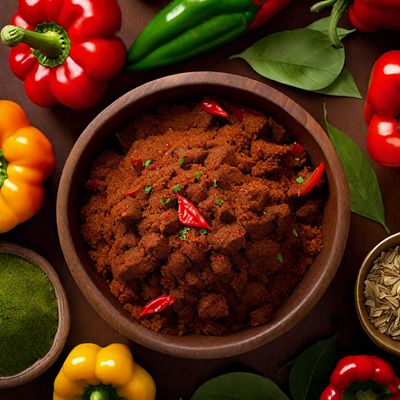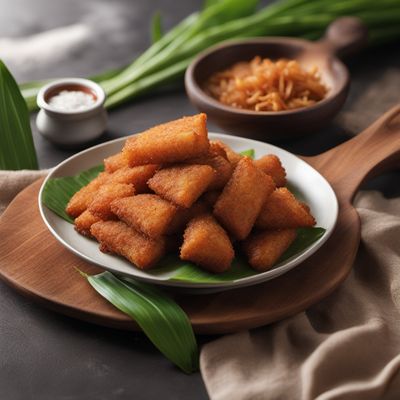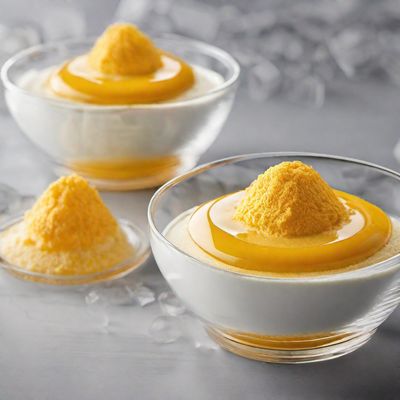
Recipe
Molecular Gastronomy Rendang
Rendang Reimagined: A Molecular Gastronomy Twist
4.8 out of 5
In the realm of molecular gastronomy, we present a modern take on the traditional Indonesian dish, Rendang. This innovative adaptation combines the rich flavors of the original recipe with cutting-edge culinary techniques, resulting in a visually stunning and gastronomically delightful experience.
Metadata
Preparation time
20 minutes
Cooking time
6 hours
Total time
6 hours and 20 minutes
Yields
4 servings
Preparation difficulty
Medium
Suitable for
Gluten-free, Dairy-free, Nut-free, Low-carb, Paleo
Allergens
N/A
Not suitable for
Vegan, Vegetarian, High-carb, Keto, Allium-free
Ingredients
While the essence of Rendang remains intact, this molecular gastronomy version focuses on transforming the texture and presentation of the dish. By utilizing techniques like spherification, emulsification, and foams, we elevate the flavors and create a unique dining experience. We alse have the original recipe for Rendang, so you can check it out.
-
500g (17.6 oz) beef, thinly sliced 500g (17.6 oz) beef, thinly sliced
-
2 cups (470ml) coconut milk 2 cups (470ml) coconut milk
-
4 kaffir lime leaves 4 kaffir lime leaves
-
2 lemongrass stalks, bruised 2 lemongrass stalks, bruised
-
4 shallots, finely chopped 4 shallots, finely chopped
-
4 cloves garlic, minced 4 cloves garlic, minced
-
2 red chilies, sliced 2 red chilies, sliced
-
1 thumb-sized ginger, grated 1 thumb-sized ginger, grated
-
1 thumb-sized galangal, grated 1 thumb-sized galangal, grated
-
1 tsp turmeric powder 1 tsp turmeric powder
-
1 tsp coriander powder 1 tsp coriander powder
-
1 tsp cumin powder 1 tsp cumin powder
-
1 tsp fennel powder 1 tsp fennel powder
-
1 tsp salt 1 tsp salt
-
1 tsp sugar 1 tsp sugar
-
Liquid nitrogen (for molecular gastronomy techniques) Liquid nitrogen (for molecular gastronomy techniques)
Nutrition
- Calories (kcal / KJ): 350 kcal / 1465 KJ
- Fat (total, saturated): 25g, 18g
- Carbohydrates (total, sugars): 5g, 2g
- Protein: 28g
- Fiber: 1g
- Salt: 1.5g
Preparation
-
1.In a sous vide bag, combine the beef, coconut milk, kaffir lime leaves, lemongrass, shallots, garlic, red chilies, ginger, galangal, turmeric powder, coriander powder, cumin powder, fennel powder, salt, and sugar. Seal the bag and cook in a water bath at 60°C (140°F) for 6 hours.
-
2.Once cooked, remove the beef from the bag and pat dry. Reserve the cooking liquid.
-
3.Using liquid nitrogen, freeze the reserved cooking liquid into small droplets.
-
4.Plate the beef slices and garnish with the frozen cooking liquid droplets.
-
5.Serve immediately and enjoy the molecular gastronomy rendition of Rendang.
Treat your ingredients with care...
- Beef — Choose a tender cut of beef, such as sirloin or tenderloin, for the best results in this molecular gastronomy rendition of Rendang.
Tips & Tricks
- To achieve the desired texture, ensure the beef is thinly sliced before cooking.
- Experiment with different molecular gastronomy techniques, such as creating foams or gels, to add additional visual and textural elements to the dish.
- Adjust the level of spiciness by adding more or fewer red chilies according to your preference.
- Serve the Rendang with a side of molecular gastronomy-inspired rice or vegetable preparations for a complete molecular gastronomy dining experience.
- Don't forget to handle liquid nitrogen with caution and follow safety guidelines when using it in the kitchen.
Serving advice
Serve the Molecular Gastronomy Rendang as the main course of a sophisticated dinner. Plate the beef slices elegantly and drizzle the frozen cooking liquid droplets over them for a visually striking presentation.
Presentation advice
For an artistic presentation, consider using a white plate as a canvas to showcase the vibrant colors of the beef and frozen cooking liquid droplets. Garnish with microgreens or edible flowers to add a touch of freshness and elegance.
More recipes...
For Rendang » Browse all
For Indonesian cuisine » Browse all
More Indonesian cuisine dishes » Browse all

Cireng
Cireng is a traditional snack from the Indonesian island of Java. It is a crispy fried dough made with tapioca flour and served with a spicy peanut sauce.

Nasi goreng kambing
Lamb Fried Rice
Nasi goreng kambing is a traditional Indonesian fried rice dish made with goat meat and a variety of spices.

Lapis legit
Spekkoek
Lapis legit, also known as thousand layer cake, is a traditional Indonesian dessert that is perfect for any occasion. It is a rich and decadent...









